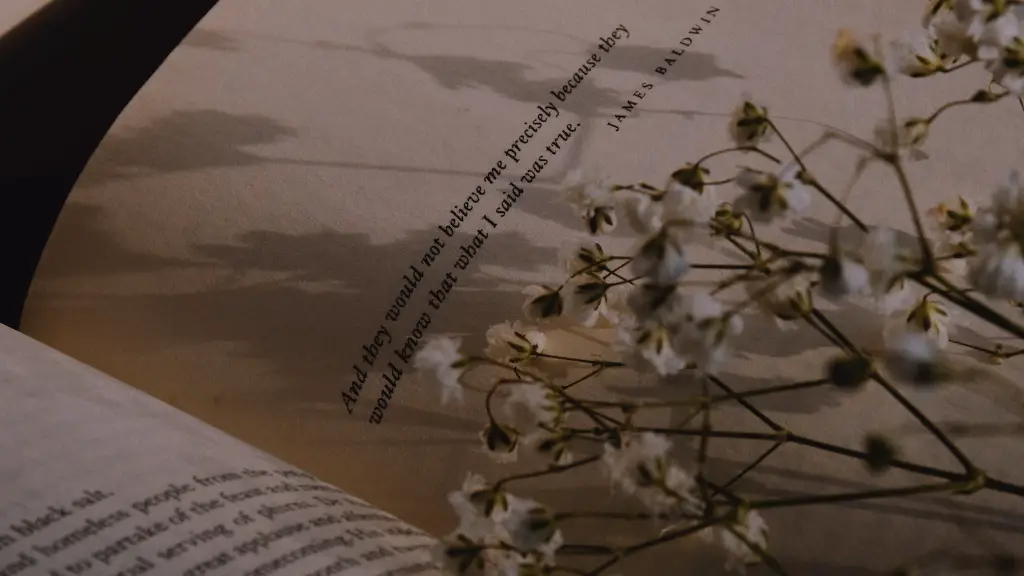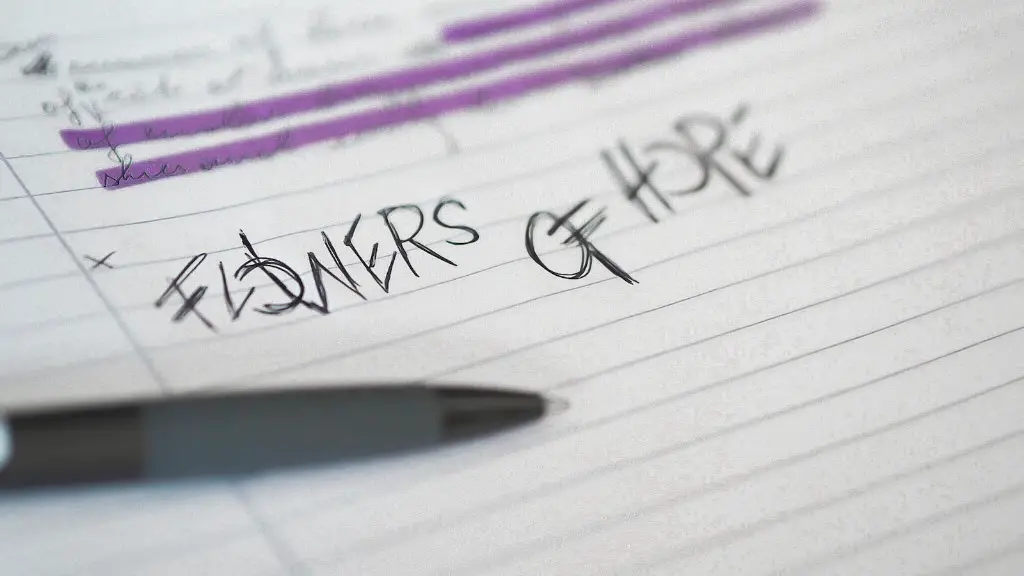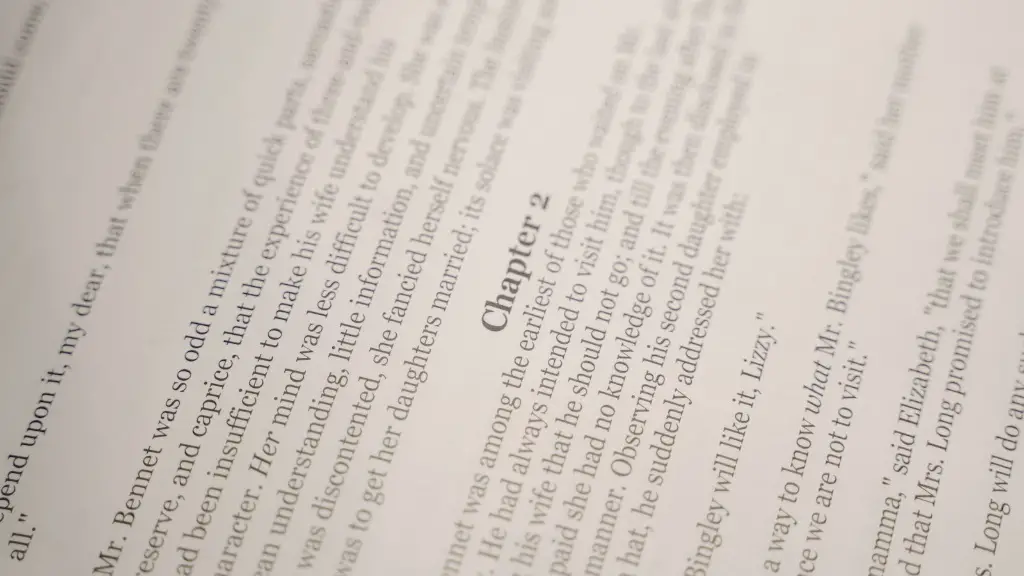Becoming Familiar with Epic Poetry
Epic poetry is a type of poem that tells a larger narrative story. It has a long and extensive history, having been around for centuries, and has been the subject of much debate amongst scholars. Epic poetry has been traditionally classified as one of three different types of poetry: epic, epyllion, and epical. The term “epic poem” is used to describe a poem that narrates a journey, a quest, and the struggles faced in pursuit of a certain goal.
Epic poems come in many shapes and sizes: epics can be poems about heroic figures, mythological creatures and adventurers; and about battles and sieges; about the creation of the world, or about individuals’ travels and experiences. The English language has seen a plethora of epic poems over its long history, from Homer’s “Iliad” and “Odyssey,” to John Milton’s “Paradise Lost,” to Robert Frost’s “Stopping by Woods on a Snowy Evening.”
Understanding the Structure of Epic Poetry
Epic poetry generally follows a certain structure and comes with distinct characteristics. Epic poems are typically within a certain length—approximately twelve books or twelve thousand lines. Furthermore, they have a certain meter, or rhythm. As a result, poets who write in a certain meter are typically classified as epic poets—Homer is noted as the epic poet par excellence.
Epic poems are also full of epithets—descriptive nicknames––which some scholars believe was used to fill the gaps in an ancient poet’s memory. These epithets can be seen in Homer’s depiction of his characters: Agamemnon is “the lord of men”; Nestor is “the Gerenian horseman”; and Achilles is “the swift-footed Achilles.” Other epic poems also possess such distinguished characters, illustrating that the ancient concept of epic poetry has lasted through the ages.
Tips for Reading Epic Poetry
When it comes to reading epic poetry, there are a few tips to keep in mind. Most inevitably, do not try to read the poem in one sitting. Epic poem contain extended passages of text and can be quite lengthy so it is best to break it up into smaller sections. This can make the poem more manageable and easier to digest.
In addition, it may be helpful to create a timeline as you read in order to keep track of the events. Having an organized timeline can help piece the parts together in your head and make it easier to remember what happened. Furthermore, it is suggested that you look up each character—understanding whom they are and their background—to gain a better picture of the poem. Doing so can help to provide context, which is necessary in understanding the poem as a whole.
Using Online Tools to Read and Analyse Epic Poetry
Aside from the traditional tools for reading and analyzing epic poetry, there are also several online tools available for reading and analyzing epic poetry.
One useful tool is called The Epic Poetics Resource Center, which is an online resource from Stanford University that features books, databases, articles, and websites related to the theme of epic poetry. The center also organizes reading groups and discussion forums to facilitate understanding and appreciation of epic poetry. Similarly, the Christian Classics Ethereal Library offers links to various sources of information about classic literature, including epic poetry.
There are also some software programs for digitizing and organizing classic texts, such as SEED and Aeneas, which allow readers to search, compare, and analyze texts. These programs attempt to extract all the elements necessary to comprehend, interpret, and analyze classic texts, including elements of grammar and syntax, and to create electronic editions.
Using Critical Approaches To Read Epic Poetry
When it comes to reading and analyzing epic poetry, there are many ways to approach the text. One method is an anthropological approach, which looks at the poem in relation to its cultural context, taking into account its historical and political origins. This involves looking at the themes, plot elements, and character development as part of a broader understanding of the poem’s moral framework or cultural underpinnings.
Another method is a literary approach, which focuses on textual analysis and looks at how the poem functions as literature. This entails looking for symbolism and literary devices, as well as the structure, plot, and characters.
Furthermore, a comparative approach can be utilized by those looking for a deeper meaning by comparing the motifs and themes in various epic poems from different cultures or perspectives. This can often provide insight into the socioeconomic and political ideas of the cultures in which the story was set.
Recognizing and Interpreting Archetypes
A critical aspect in interpreting epic poetry involves recognizing and interpreting its archetypes. An archetype is a recurring symbol across stories, cultures, and time periods. The most common archetypes in epic poetry include the hero, the quest, and the epic battle.
The hero is usually depicted as a strong figure who is set on a journey with a purpose. He or she is often accompanied by supporting characters, such as wise advisors and loyal companions. The quest or journey is usually a difficult challenge with daunting obstacles, including various enemies—sometimes physical, sometimes supernatural—that the hero must face and conquer. Finally, the epic battle is a climactic event where the hero and their enemies have a showdown, with either side winning in the end.
Searching For Meaning In The Subtext
Though epic poetry typically places emphasis on the hero’s physical battle, more often than not, the underlying themes reveal an inner voyage. It is believed that the hero’s successes and failures reflect on the journey of the audience, and so it is important to not glean solely upon the surface level story at hand.
In some cases, a hero may face difficult choices with far reaching consequences that can be related to life. It is important to recognize the commentary it may make on human behaviour or the larger narrative of culture, history, and religion. Subtext can be found by looking for recurring symbols and motifs, such as death, fate, revenge, or punishment.
Gaining Insight from Literary Criticism
Rather than attempting to interpret the poem alone, some readers may benefit from consulting literary criticism, which can provide greater insight into the poem’s history, culture, and context. Literary criticism can also provide a modern, more contemporary understanding of the poem and can bridge the gap between the original narrative and the reader.
Moreover, when reading the poem in its original language, having access to translations and interpretations of the text can be incredibly helpful in order to fully understand the poem’s cultural and historical roots. Furthermore, there are many commentaries and essays written by scholars and poets, providing deeper interpretations of the poem and providing readers with a more comprehensive understanding of the text.
Using Visualization Techniques to Gain Insight
Finally, another way to understand and appreciate epic poetry is through visualization. Visualization seeks to bring the text to life through images, and has long been used to explore literature. Visualizations such as maps and infographics can be used to illustrate the characters’ path of their journey or the conflicts and battles they face.
Also, by using various methods and tools, it is possible to track the flow of the story or to graph the various events and relationships between the characters. This can help to provide a more in-depth analysis of the story and aid in understanding the nuances of the text.
Developing Your Own Interpretations
While the interpretation of an epic poem is a subjective activity, understanding the poem in its original language and its textual structure will aid in constructing an individual interpretation of the poem. Moreover, many passages invite readers to come to their own conclusions and interpretations that may be unique to them and their experiences.
By forming connections between personal experiences and the poem, a more nuanced and unique interpretation can subsequently be formed. Doing so can allow readers to gain insight into the story and draw their own conclusion regarding its themes and ideas. Ultimately, finding and understanding a poem’s subtleties can provide a more profound reading experience and can help to foster critical thinking.
Exploring Reflections of the Poem Through Contemporary Art
Exploring reflections of the poem through contemporary art is another useful way to gain a better insight into the text and its messages. This can be done by looking for illustrations, paintings, performances or movies that may reflect the essence of the story.
For example, for Paradise Lost, there are several adaptations, such as in Milton’s Lost Paradise in jazz form, which helps to explore how the appeals of an epic poem can be utilized today in different artistic mediums. Furthermore, there are a variety of YouTube videos and podcasts that provide further discussion and insight into different epic poems.
Taking Advantage of Online Discussion Groups
In addition, online discussion groups, such as Reddit’s State of the Epic subreddit, can provide a platform where readers can exchange their views and interpretations of epic poetry. This type of group forum provides an opportunity for greater interaction and discussion with other readers, enabling members to gain further insight into the poem and understand the different perspectives and interpretations of the same text.
Furthermore, online discussion groups can provide a space to share sources and materials related to the epic poem and offer advice on the best places to start reading and finding further information. By participating in such groups, readers can grow their knowledge and understanding of epic poetry.
Conclusion
In conclusion, it is possible for readers to gain an appreciation for epic poetry by becoming familiar with its structure and its traditional characteristics, such as its meter and the use of epithets. Additionally, by utilizing visualization techniques, literary criticism and online discussion groups, readers can gain a better understanding of the poem and its underlying meanings and messages. Lastly, by exploring the hero’s quest and the poem’s broader contexts and by understanding its archetypes, readers can gain insights into the moral framework and cultural underpinnings of the poem. Ultimately, it is only by embracing the challenge of reading and understanding epic poetry that its true beauty and power can be fully appreciated.



